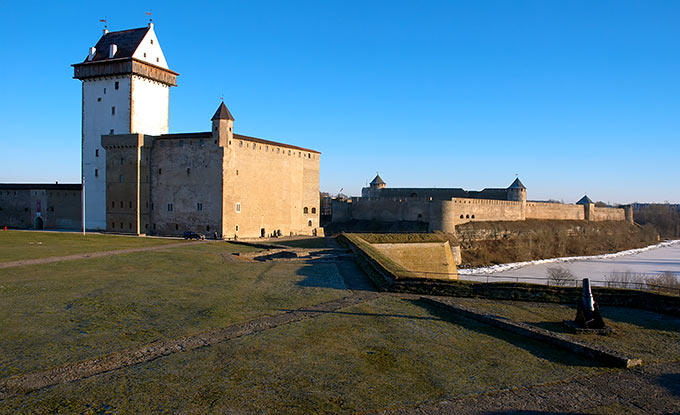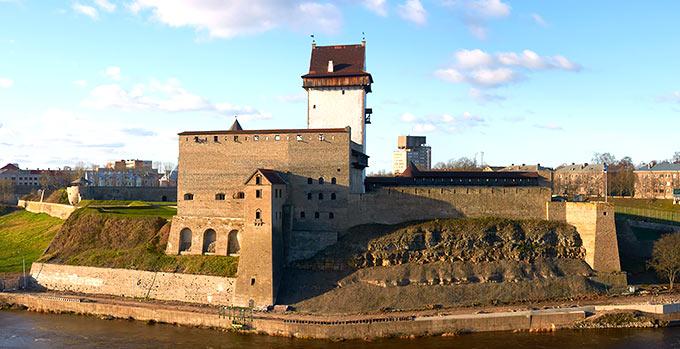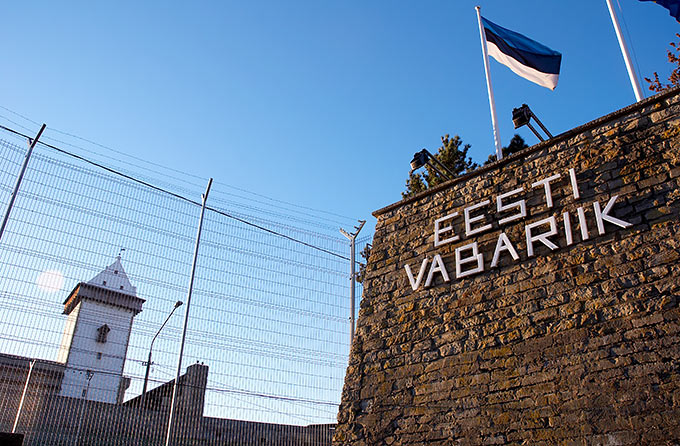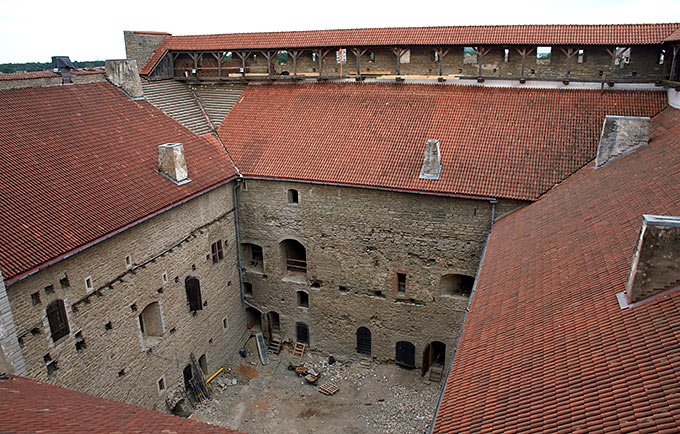History of Narva fortress
First mention about Narva settlement was made in Novgorod annals in 1171. One of the Novgorod's streets was named as "Narvskij Konetz" (Narva's End). Traces of prehistoric settlements in the Narva town area dates 5-6 thousands years AC. Lifland's annals says Narva was founded soon after Revel foundation (near to 1223) by Danish ruler of Estland Ditrich fon Kivel.
Town's progress was quick and in 1294 it has it's forstadts (outskirts) on opposite right bank of Narva river already. The place was extremely busy because of trade way, so these forstadts were pillaged and burned by Russians from Novgorod. In 1342 they got and burned Narva itself.
In 1347 Danish king Valdemar III sold Narva with it's environment to Livonians Order for 19000 Köln's marks. Narva was under Livonians knights rule till 1558. The city got new walls with gates and towers during that time.
In 1492 fortress Ivangorod was erected on the opposite riverside by the order of Russian tzar Ivan III. Old confrontation got new expansion. Mutual shellings, quarrels, disagreements about lands, fisheries, etc. became common between two towns.
In 1558 Russia unleashed Livonian war. Early April 1558 artillery skirmish between Narva and Ivangorod begun. May, 11 huge fire appeared in Narva. Cause of that fire is unclear till nowadays. All city archives of Livonians times were lost in that fire. Russians from Ivangorod crossed the river quickly and seized the city.
After conquest of Narva Moscow power made it main trade port on Baltic sea. This was, of course, good deal for the city, despite of Swedish privateers, which begun to hijack merchant ships on the trade ways to Narva. One more blow for Narva's commerce was debacle of Ivan the Terrible's "oprichniks" in 1570.
In 1574 new warfare between Swedes and Russians begun in Estland. In 1579 Narva was besieged by Swedes under command of G.Gorn. In 1581 famous Pontus Delagardi with big Sweden army stormed the city. After two days bombardment and fierce storm Narva capitulated. Near to 7000 Russians were slain during that battle.
Narva under Swedish rule did not get an easy life. In 1590 big Russian 80000 army under command of Boris Godunov appeared under it's walls. After 17-th days bombardments they tried to storm, but were repulsed. Nevertheless commandant of Narva K.Gorn went to negotiations with Russians and in consequence of that negotiations Russians rose the siege of Narva and got in possession fortresses Jam (Jamburg), Koporje and Ivangorod. The war finished in 1595. Big fire of 1610 in Narva city done the distress of war.
In the end of 1640-th Narva was rebuilt and became main trade point of Swedes in their eastern trade. It's fortifications were rebuilt also and it's garrison reinforced. Ivangorod or Russian Narva became the part of Narva itself from that time.
In 1655 new war with Russia begun. Russian skirmishers burnt Narva's outskirts repeatedly. Additionally the plague devastated Narva and all south Baltic coast in 1658.
New fortification building construction in Narva began in 1680-th under the supervision of famous engineer Eric Dalberg. Early in 18 AC Narva became one of the powerful fortress of Swedes.
In 1700 the Northern War broken out. Early September 34000 Russian army (80000 by foreign data) with Peter the Great at the head besieged the city. Early October artillery bombardment began. But Sweden king Charles XII hit the beach in Revel with 8500 army, dashed to Narva and hammered and dispersed Russians after one day hot battle.
In 1704 tzar made a new assault. In the end of May the city was blocked by Russians under command of marshal Ogilvi. Fierce bombardment began in the end of July. August 6 faces of bastion Honor were demolished and two breaches were made in the faces of bastion Victoria. August 9 the general storm began and the city fell within one hour. Two hours massacre ensued after that and as wrote Peter the Great to Feodor Romadanovsky: "There was a good tractament (behavior to..., affair) with the foes, so few from children survived". In August 16 Ivangorod gave up to Russians too.
In 1708 Sweden population of Narva was removed to Vologda and Kazanj areas because of suspicions in their unloyalty. Some of them could return to Narva in 1714.
After Northern War the Narva's military star began decline and in 1863 the fortress was out of the rank. The town in contrary carry it's development on and became an important economic center of cloth and huckaback manufacturing. In 1857 the famous Krenholm manufacture was established in the city. In 1750 railway from St.Petersburg to Revel (Tallinn) was built through Narva.
1918 was the era of turbulence in Russian Empire. February 24 Estonian Republic was proclaimed in Tallinn, but Germans occupied the country and March 4 they seized the city. November 1918 after revolution in Germany the occupation was broken up and the "bolsheviks" got the city and promulgated the Eastland Working Commune. After two month the city was besieged by 1-st Estonian division, "bolsheviks" flied and Narva with Ivangorod became a part of independent Estonia.
In August 1940 Narva with whole Estonia was annexed by USSR. July 1941 the city endured first German air-raids. City railway station was badly hit by blow of troop-train with ammunition. Germans seized Narva in August 1941. After that there were a plenty Soviet air-raids - to the river bridges mainly.
In January 1944 just before the main Soviet offensive Germans evacuated all Narva's population. February 2 Soviets reached the Narva river and tried to establish bridge-head, but were repulsed. More attempts were made later in February but in vain too. March 6 and 7 Soviet aviation made the two devastating night air-raids to Narva city and Krenholm, which literally razed the old city to the ground. Heavy artillery bombardment finished the town off. Fierce fighting terminated with German's retreat to "Tannenberg Line" in 20 km west. Just before retreat they undermined all remained houses and church's bell towers.
After WW2 only 100 houses from prewar 3500 remained in Narva. Sovmin Estinian SSR (Government of Estonian Soviet Socialist Republic) was determine to restore the old city of Narva primarily, but in 1950 all ruins of Narva were demolished by the order of Narva gorispolkom (city government). After that in 1960-th Narva got it's present gray-brick physiognomy. The Hermann Castle reconstruction began in that times too.
At last in August 1991 independent Estonian Republic was restored and Narva river became a border line between the East and the West again. What all we fought for...?
Impressions
It is a most cheap and fastest trip to Europe from Asia. Transportation from Saint-Petersburg to Ivangorod lasted near to 3 hours by bus (~5 euros), than you need to go through three checkpoints and cross-questioning on Estonian custom. But all of it was not in vain. There are many interesting things in Narva to wonder about. The ancient castle with 50 meters height tower, magnificent sights of Narva and Ivangorod fortress, old bastions with underground passages... And do not forget about "Vana Tallinn" ~5 euro/0.5 litre cost.
Land forts and fortress:
Bip Castle Gatchina Ivangorod Izborsk Kexholm Kirillov Monastery Koporye Novgorod Pechorskiy Monastery Peter&Paul Fortress Porkhov Pskov Schlisselburg Staraya Ladoga Tikhvin Vyborg Hameenlinna Hamina Kastelholm Kymenlinna Lappaenranta Raseborg Castle Savonlinna Tavetti Turku Visby Fredrikstadt Fredriksten Hegra Fort Hoytorp Fort Arensburg Narva Tallinn Antipatris Caesarea Jerusalem Latrun Fort Masada
Sea forts and fortresses:
Alexander Fort Ino Fort Krasnaya Gorka Fort Kronstadt: Kotlin isl. Kronstadt: North Forts Kronstadt: South Forts Trongsund Hanko Svartholm Sveaborg Marstrand Siaro Fort Vaxholm Oscarsborg
Artillery batteries and individual guns:
Coastal Artillery Hemso Fort
Fortified areas and defensive lines:
Karelian Fortified Area (KaUR) KrUR Leningrad Mannerheim Line Nevsky Bridgehead VT Line Harparskog Line Salpa Line Gothland
Russian
S e a r c h All news


 Narva Castle, view from the Ivangorod fortress.
Narva Castle, view from the Ivangorod fortress.




